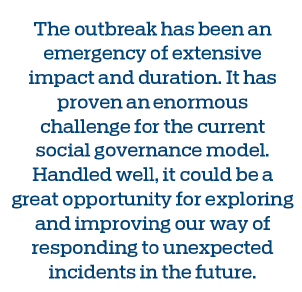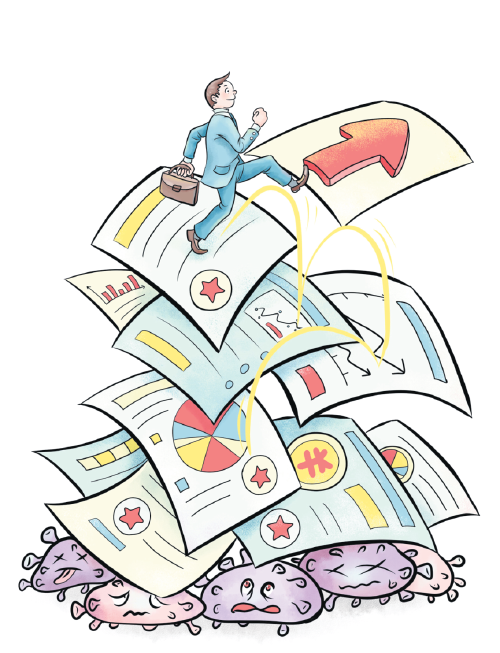Fiscal support to weather the storm

Necessary to implement more measures since the epidemic has not yet ended and the future remains uncertain
To respond to the unprecedented challenge of the novel coronavirus epidemic, the central government has unveiled a series of measures. The People's Bank of China, China's central bank, has injected an enormous amount of liquidity through multiple rounds of monetary policy measures as a timely response to buffer the shocks of the epidemic to economic and financial stability.
Provincial and local governments across China have been following suit in providing assistance in areas such as financing, rental and leases, taxes and utilities to companies affected by the epidemic.
These policy measures are essential to bring the situation under control and to alleviate the negative effects of the epidemic, and so far they have proven to be effective. Having said that, it is necessary to explore and release follow-on measures as the epidemic has not yet ended and the future remains uncertain.
First, fiscal policy should be prioritized among all policy options and be allowed to play a central role. In light of the scale and severity of the epidemic, fiscal policy can focus on further reducing taxes and fees on small and medium-sized enterprises and on providing direct subsidies to companies that play an outsized role in maintaining people's livelihoods, which have been hard hit by the outbreak. The State Council has announced measures to waive or reduce social security payments in phases and allow companies to delay contributions to the Housing Provident Fund. This policy is a timely measure, and will be fundamental for helping businesses in general and small and medium-sized enterprises in particular to survive the hardship.
In this vein, fiscal policies could also include raising the threshold on personal income tax so that people are left with more disposable income to spend. Such a policy would not only help with the current epidemic response but also contribute to the transition of the country's development model in the long run.
On the other hand, fiscal policies should also focus on boosting investment in infrastructure projects that are closely related to people's livelihoods. This can ultimately help expand aggregate demand. It is particularly important to drastically increase the fiscal commitment to public health to clear the bottleneck in the allocation of medical and health resources, as the outbreak brought in sharp relief investment gaps in prevention, medical staff and hospitals. Statistics show that China spent 6.6 percent of its GDP on health in 2018, while developed countries in Europe and the United States spent over 10 percent of the GDP on health. Per capita spending on health in China is even lower when one takes into consideration its vast population. Reversing this situation could help unlock high-quality economic growth and achieve our aspiration of a moderately prosperous society.
Currently, China's deficit stands at around 3 percent of GDP, a level lower than that of many developed and developing countries alike, which means that it still has some policy space. It may be wise to consider increasing the fiscal deficit to 4 percent of GDP in 2020 and issuing special treasury bonds to make up the difference.
Second, the People's Bank of China may consider additional reductions in the reserve requirement ratio (RRR) and benchmark lending rates, which would help SMEs to weather the storm through facilitating the release of liquidity on one hand and reducing the costs of borrowing on the other.
Third, since the start of the Sino-US trade conflict, foreign investors in some areas in China have been gearing up to move their supply chains to third-party countries. With stricter traffic controls in some cities and lockdowns of others since the outbreak of the epidemic, companies heavily dependent on global value chains (automakers, electronics manufacturers and pharmaceutical companies, for example) have been struggling to reopen after the Chinese New Year holiday or sell their goods. This may exacerbate the flight of foreign investors and heighten the risk of decoupling from the world economy. It may be time for the relevant government authorities to consider rolling out timely measures aimed at foreign investors that have been hard hit by the epidemic. These measures could include, for example, temporary relief on taxes, loans and foreign exchange. The key is to help these investors reopen their businesses and factories as early as it is safe to do so, so as to avoid prolonging the impact of the epidemic.
Fourth, expansionary fiscal and monetary policies can make effective short-term responses to downward pressures on growth. Having said that, fiscal and monetary policies can only be expansionary to a certain point, and the long-term consequences must be considered. In fact, another important tool (and one with longer-lasting benefits) to counteract downward pressures is market-driven supply-side reform, which can boost total factor productivity and help fully leverage the decisive role of the market in resource allocation, while at the same time mobilizing private enterprises by shoring up their business confidence.
The outbreak has been an emergency of extensive impact and duration. It has proven an enormous challenge for the current social governance model. Handled well, it could be a great opportunity for exploring and improving our way of responding to unexpected incidents in the future. Government authorities can draw lessons from other countries in this regard and heed the experts in their insights and recommendations. In this way, we can create more agile and evidence-based alert and response mechanisms that are based on enhanced exchange of information.
The author is Chief Economist of PwC China and professor of the School of Finance with Central University of Finance and Economics. The author contributed this article to China Watch, a think tank powered by China Daily. The views do not necessarily reflect those of China Daily.






















